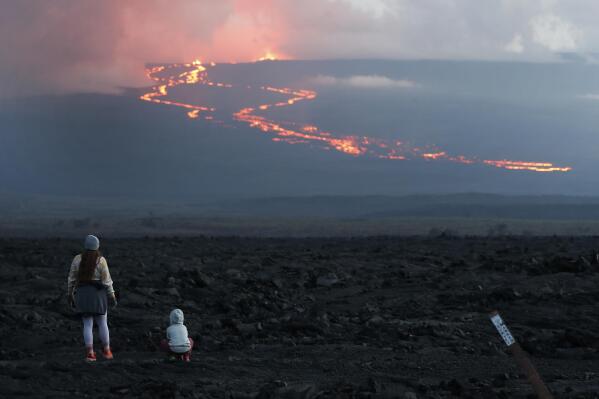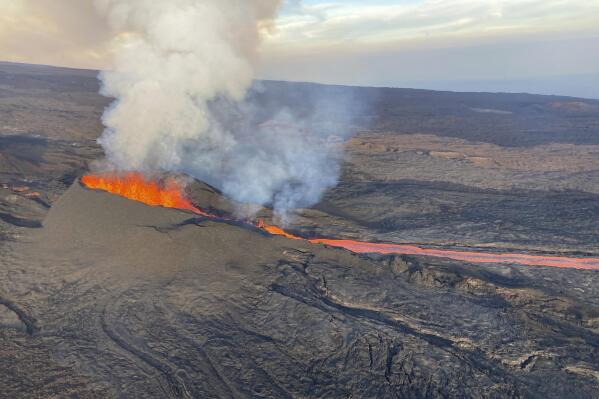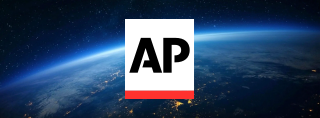Scientists lower alert for Mauna Loa, say eruption could end
Scientists lower alert for Mauna Loa, say eruption could end

FILE - Spectators watch the lava flow down the mountain from the Mauna Loa eruption, Nov. 29, 2022, near Hilo, Hawaii. On Wednesday, Dec. 7, the lava from Mauna Loa, was 1.8 miles from Saddle Road, also known as Route 200 or Daniel K. Inouye Highway, scientists with the U.S. Geological Survey said. (AP Photo/Marco Garcia, File)

FILE - People watch and record images of lava from the Mauna Loa volcano Thursday, Dec. 1, 2022, near Hilo, Hawaii. Officials monitoring the Mauna Loa eruption on Hawaii’s Big island said Wednesday, Dec. 7, the lava flow moving toward state Route 200 has slowed. They said they could not predict when, where or if the lava flow would cross the highway. (AP Photo/Gregory Bull, File)

In this aerial image provided by the U.S. Geological Survey, fissure 3 is seen erupting on the Northeast Rift Zone of Mauna Loa on the Big Island of Hawaii, Wednesday, Dec. 7, 2022. The world’s largest volcano continues to erupt but scientists say lava is no longer feeding the flow front that has been creeping toward a crucial highway. That means the flow isn’t advancing and is no longer an imminent threat to the road that connects the east and west sides of the Big Island. (U.S. Geological Survey via AP)

Ashlyn Nadeau, left, stands next to her husband, Casey Nadeau, second from left; Jessica Doyle, second from right, and Justin Potter, right, as they take a picture below the Mauna Loa volcano as it erupts Friday, Dec. 2, 2022, near Hilo, Hawaii. (AP Photo/Gregory Bull)

Lava flows as the Mauna Loa volcano erupts Saturday, Dec. 3, 2022, near Hilo, Hawaii. (AP Photo/Gregory Bull)

FILE - A man talks on a phone in his car alongside Saddle Road as the Mauna Loa volcano erupts Wednesday, Nov. 30, 2022, near Hilo, Hawaii. The world’s largest volcano continues to erupt but scientists say lava is no longer feeding the flow front that has been creeping toward a crucial highway. That means the flow isn’t advancing and is no longer an imminent threat to the road that connects the east and west sides of the Big Island. (AP Photo/Gregory Bull, File)

Lava flows through fissures as the Mauna Loa volcano erupts Saturday, Dec. 3, 2022, near Hilo, Hawaii. (AP Photo/Gregory Bull)

A woman records with her phone as the Mauna Loa volcano erupts Saturday, Dec. 3, 2022, near Hilo, Hawaii. (AP Photo/Gregory Bull)

The Mauna Loa volcano erupts Saturday, Dec. 3, 2022, near Hilo, Hawaii. (AP Photo/Gregory Bull)

FILE - Spectators watch the lava flow down the mountain from the Mauna Loa eruption, Nov. 29, 2022, near Hilo, Hawaii. On Wednesday, Dec. 7, the lava from Mauna Loa, was 1.8 miles from Saddle Road, also known as Route 200 or Daniel K. Inouye Highway, scientists with the U.S. Geological Survey said. (AP Photo/Marco Garcia, File)
FILE - Spectators watch the lava flow down the mountain from the Mauna Loa eruption, Nov. 29, 2022, near Hilo, Hawaii. On Wednesday, Dec. 7, the lava from Mauna Loa, was 1.8 miles from Saddle Road, also known as Route 200 or Daniel K. Inouye Highway, scientists with the U.S. Geological Survey said. (AP Photo/Marco Garcia, File)

FILE - People watch and record images of lava from the Mauna Loa volcano Thursday, Dec. 1, 2022, near Hilo, Hawaii. Officials monitoring the Mauna Loa eruption on Hawaii’s Big island said Wednesday, Dec. 7, the lava flow moving toward state Route 200 has slowed. They said they could not predict when, where or if the lava flow would cross the highway. (AP Photo/Gregory Bull, File)
FILE - People watch and record images of lava from the Mauna Loa volcano Thursday, Dec. 1, 2022, near Hilo, Hawaii. Officials monitoring the Mauna Loa eruption on Hawaii’s Big island said Wednesday, Dec. 7, the lava flow moving toward state Route 200 has slowed. They said they could not predict when, where or if the lava flow would cross the highway. (AP Photo/Gregory Bull, File)

In this aerial image provided by the U.S. Geological Survey, fissure 3 is seen erupting on the Northeast Rift Zone of Mauna Loa on the Big Island of Hawaii, Wednesday, Dec. 7, 2022. The world’s largest volcano continues to erupt but scientists say lava is no longer feeding the flow front that has been creeping toward a crucial highway. That means the flow isn’t advancing and is no longer an imminent threat to the road that connects the east and west sides of the Big Island. (U.S. Geological Survey via AP)
In this aerial image provided by the U.S. Geological Survey, fissure 3 is seen erupting on the Northeast Rift Zone of Mauna Loa on the Big Island of Hawaii, Wednesday, Dec. 7, 2022. The world’s largest volcano continues to erupt but scientists say lava is no longer feeding the flow front that has been creeping toward a crucial highway. That means the flow isn’t advancing and is no longer an imminent threat to the road that connects the east and west sides of the Big Island. (U.S. Geological Survey via AP)

Ashlyn Nadeau, left, stands next to her husband, Casey Nadeau, second from left; Jessica Doyle, second from right, and Justin Potter, right, as they take a picture below the Mauna Loa volcano as it erupts Friday, Dec. 2, 2022, near Hilo, Hawaii. (AP Photo/Gregory Bull)
Ashlyn Nadeau, left, stands next to her husband, Casey Nadeau, second from left; Jessica Doyle, second from right, and Justin Potter, right, as they take a picture below the Mauna Loa volcano as it erupts Friday, Dec. 2, 2022, near Hilo, Hawaii. (AP Photo/Gregory Bull)

Lava flows as the Mauna Loa volcano erupts Saturday, Dec. 3, 2022, near Hilo, Hawaii. (AP Photo/Gregory Bull)

FILE - A man talks on a phone in his car alongside Saddle Road as the Mauna Loa volcano erupts Wednesday, Nov. 30, 2022, near Hilo, Hawaii. The world’s largest volcano continues to erupt but scientists say lava is no longer feeding the flow front that has been creeping toward a crucial highway. That means the flow isn’t advancing and is no longer an imminent threat to the road that connects the east and west sides of the Big Island. (AP Photo/Gregory Bull, File)
FILE - A man talks on a phone in his car alongside Saddle Road as the Mauna Loa volcano erupts Wednesday, Nov. 30, 2022, near Hilo, Hawaii. The world’s largest volcano continues to erupt but scientists say lava is no longer feeding the flow front that has been creeping toward a crucial highway. That means the flow isn’t advancing and is no longer an imminent threat to the road that connects the east and west sides of the Big Island. (AP Photo/Gregory Bull, File)

Lava flows through fissures as the Mauna Loa volcano erupts Saturday, Dec. 3, 2022, near Hilo, Hawaii. (AP Photo/Gregory Bull)

A woman records with her phone as the Mauna Loa volcano erupts Saturday, Dec. 3, 2022, near Hilo, Hawaii. (AP Photo/Gregory Bull)
HONOLULU (AP) — Scientists lowered the alert level for the Mauna Loa volcano on Hawaii’s Big Island from a warning to a watch on Saturday and said the mountain’s first eruption in nearly 40 years may soon end.
The U.S. Geological Survey’s Hawaiian Volcano Observatory said in a bulletin that the eruption on the mountain’s northeast rift zone was continuing, but lava output and volcanic gas emissions were “greatly reduced.”
“High eruption rates will not resume based on past eruptive behavior and current behavior suggests that the eruption may end soon,” the observatory said. “However, an inflationary trend of Mauna Loa’s summit is accompanying the decreased activity and there is a small possibility that the eruption could continue at very low eruptive rates.”
Meanwhile, it said, a lava flow front had “stagnated” nearly 2 miles from Saddle Road, the vital highway that residents and tourists alike use to travel between the city of Hilo on the east side of the island and coastal resorts to the west.
Scientists said earlier this week that the road was no longer under imminent threat from the lava, allaying fears previously that it could be cut off.
Mauna Loa began spewing molten rock Nov. 27 after being quiet for 38 years, drawing onlookers to take in the incandescent spectacle and setting some nerves on edge early on among people who’ve lived through destructive eruptions. For many Native Hawaiians, the phenomenon has a deep yet very personal cultural significance.
The observatory said its scientists were continuing to monitor the volcano closely, and flight restrictions remained in place in the area up to 1,500 feet (457 meters) above ground level.

